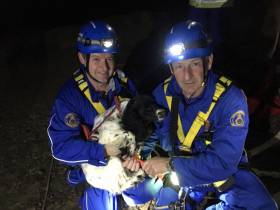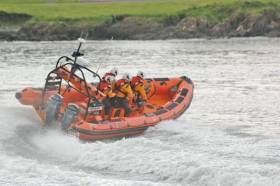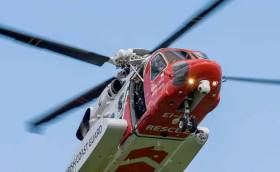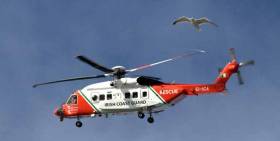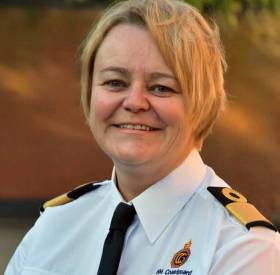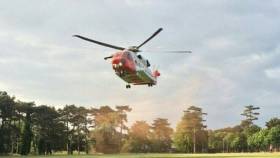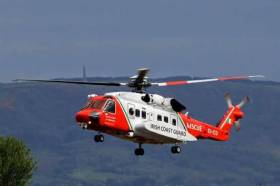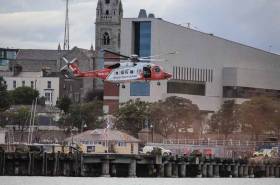Displaying items by tag: Coastguard
#Rescue - Coastguard units from Ballycastle and Coleraine were tasked on Friday night (26 May) to the aid of a dog fell more than 30 feet off a cliff near the Giant’s Causeway in Co Antrim.
The coastguard teams used their specialist rope rescue equipment to lower a technician down the cliff to secure Bell the springer spaniel and lift her up to her grateful owners.
Belfast Coastguard reminds anyone with pets on or near the water to keep them on leads, especially close to cliffs. If an accident should happen, don't attempt a rescue yourself – always call the coastguard who are trained for the purpose.
In other news from the North Coast, the iconic Carrick-a-Rede rope bridge is closed until further notice after vandals attempted to cut it down.
TheJournal.ie has more on the incident last week, as the National Trust awaits investigation by structural engineers to determine the extent of the damage to the coastal tourism attraction.
#Missing - Police Scotland confirmed that two bodies were recovered from the Irish Sea in the search for a speedboat missing off the Scottish coast, according to Yachting & Boat World.
RNLI lifeboats and coastguard volunteers from Northern Ireland were involved in the search for the speedboat and its two occupants off Dumfries and Galloway, as reported yesterday on Afloat.ie.
#Rescue - A surfer was rescued from the sea off Northern Ireland yesterday evening (Monday 1 May) after more than 30 hours in the water.
Belfast Coastguard co-ordinated the search for the missing man who had gone surfing near Campbeltown in Argyll, Western Scoland on Sunday and failed to return.
A large area of sea and shoreline was searched from lunchtime on Monday when the alarm was raised, involving RNLI lifeboats from Campbeltown and Islay in Scotland and Red Bay in Co Antrim, as well as coastguard rescue teams from Campbeltown, Southend, Gigha, Tarbert and Port Ellen, and HM Coastguard’s rescue helicopter based at Prestwick.
Dawn Petrie at Belfast Coastguard Operations Centre, who was co-ordinating the search, said: “Hope was fading of finding the surfer safe and well after such a long period in the water and with nightfall approaching we were gravely concerned.
“But at 7.30pm tonight, the crew on the coastguard rescue helicopter were delighted when they located the man still with his surfboard and 13 miles off the coast.
“He was kitted out with all the right clothing including a thick neoprene suit and this must have helped him to survive for so long at sea. He is hypothermic but conscious and has been flown to hospital in Belfast.”
HM Coastguard reminds all coastal users this summer to be prepared before you go out on the water or at the coast where conditions can change quickly. Tell someone where you are going and take an appropriate means of raising the alarm in an emergency.
RNLI Add:
A Northern Ireland lifeboat was involved in the huge search and rescue operation for a missing surfer who left a Scottish beach on Sunday morning and spent 32 hours at sea before being found last night (Monday 1 May). Red Bay RNLI were requested to launch by Belfast coastguard to join with the Scottish lifeboats, Campbeltown and Islay, along with rescue teams from Campbeltown, Southend, Gigha, Tarbert and Port Ellen and the Coastguard rescue helicopter based at Prestwick. The man was eventually located by the coastguard helicopter and transferred to hospital.
The young man had set off to go surfing off the Argyll coast on Sunday morning and had not been heard from since 11.30am. In a huge search operation RNLI lifeboats were launched on both sides of the Irish Sea with Scottish and Irish lifeboats searching the extensive body of water for the missing man.
At 7.30pm the missing surfer was located by the coastguard helicopter and was still with his surfboard 13 miles off the coast.
Commenting on the search and rescue operation Red Bay RNLI Coxswain Paddy McLaughlin said, ‘This was a huge search and rescue operation. To have lifeboats launched from both Scotland and Ireland shows the incredible effort that went into the search. Our lifeboat crews along with our colleagues in the coastguard undertook an extensive and detailed search in the large area between the two coasts and thankfully this resulted in a successful outcome.’
‘The young man wore the correct clothing and stayed with his surfboard, giving himself valuable time and keeping safe. It just shows that even after 32 hours at sea people can be found and rescued. We wish the young man a full recovery after his ordeal.’
After four weeks searching for missing crew of Coastguard Rescue Helicopter 116, the Air Accident Investigation Unit and An Garda Síochána in conjunction with Coast Guard have expressed their sincere appreciation to the Commissioners of Irish Lights (CIL) and Marine Institute who were supported by GSI (Geological Survey Office), for the extensive search conducted in the vicinity of Black Rock lighthouse following the tragic loss of Coast Guard helicopter Rescue 116 on March 14.
The search operation conducted by the Marine Institute's Holland 1 ROV concluded this afternoon when the Granuaile departed Blacksod Bay.
Supt. Tony Healy confirmed that the Garda water unit would conduct diving searches in the vicinity of Blackrock Light as soon as wind and tidal conditions are considered suitable.
He also confirmed that he had requested Coast Guard and Civil Defence volunteers to continue with targeted searches of coastal areas and monitoring of specific areas of interest.
Gerard O'Flynn from the Coast Guard thanked all the statutory and voluntary organisations for their unstinting support over the past four weeks, paying special thanks to Coast Guard, RNLI and Civil Defence volunteers and Defence Forces assets including naval divers, ships and Air Corps. He added that the operation highlighted the value of inter-agency cooperation in meeting challenges of this type.
The Coast Guard also wishes to remind all mariners to keep a good lookout for any material associated with Rescue 116 and to report any findings to Malin Head Coast Guard Coordination Centre.
AGS, AAIU and IRCG reiterated their sympathy to the families of Dara Fitzpatrick, Mark Duffy, Paul Ormsby and Ciaran Smith and expressed the hope that with the extensive monitoring both at sea and on shore that the remains of Paul and Ciaran would be found.
Search Continues for Missing Crew of R116
Remote Operations Vehicle (ROV) operations, conducted by Marine Institute specialists on-board the Granuaile in conjunction with An Garda Síochána and the Air Accident Investigation Unit continued overnight and are ongoing. Wind has freshened overnight, which may constrain certain elements of the proposed search until Sunday, but conditions remain favourable for time being. Air, surface and shoreline searches are ongoing today, supported by Coast Guard, RNLI and Civil Defence volunteers. The Shannon based Coast Guard helicopter will conduct aerial searches later today. The Air Corps are also supporting the search.
Also the Coast Guard wishes to request all mariners, particularly those not participating on Saturday 8th April, to continue to keep a good lookout for any material associated with R116 and report any sightings to Malin Head Coast Guard Co-ordination Centre.
The Maritime & Coastguard Agency’s new Head of Maritime Operations, Julie-Anne Wood, has made history by becoming the first woman to achieve this rank in the history of Her Majesty’s Coastguard.
The role of Head of Maritime Operations heads up the National Maritime Operations Centre in Fareham and the 10 Coastguard Operations Centres that co-ordinate search and rescue around the UK coast. It is one of the most senior roles in HM Coastguard, part of the Maritime & Coastguard Agency, and up until now, the role has always been held by a man.
Julie-Anne Wood began her Coastguard career in the Welsh coastal town of Milford Haven in 1999 as a part-time Coastguard Watch Assistant. Before that, she ran her own business providing safety training to fishermen and merchant seamen in Wales. An opportunity for a permanent Coastguard Watch Assistant came up and in Julie-Anne’s words, she ‘never looked back’.
Over the next nine years, Julie-Anne progressed through the ranks to Watch Officer, Watch Manager and then Rescue Co-ordination Centre Manager in 2008. In 2011, her career changed direction, where she fulfilled her long-term goal to become a Coastguard Technical Trainer within the HR team. In 2013, she became head of Technical Training and Standards and in 2014 she temporarily covered the role of Head of Maritime Operations. In January 2017, she was appointed to the position permanently.
Julie-Anne says she didn’t set out to make HM Coastguard history. It was just a natural advancement of her career. ‘It’s a huge responsibility and a position that I’m very honoured to hold. What may have once been a male-dominated industry is very different these days. The Maritime & Coastguard Agency has incorporated women in everything they do. In my experience, there have been no restrictions. I have never allowed my gender to get in the way of my career – that’s one of the great things about HM Coastguard – the only limits on women are those that are imposed by themselves.
‘I am fortunate to be surrounded by an extraordinary team of strong women and men who are driven, talented and deliver an incredible service 24 hours a day.'
Despite her success, Julie-Anne has said that her proudest moments are still engrained in bringing people home to their families. ‘Every rescue is different, but the feeling you get when we’ve rescued someone in their darkest hours still makes a huge impression on me emotionally. There is no better feeling than seeing families reunited and know that you’ve played a part in that.’
'No Mechanical Anomalies' On Coastguard Helicopter R116
The Chief Inspector of Air Accidents, Mr. Jurgen Whyte, in conjunction with the appointed Investigator-in-Charge, Mr. Paul Farrell, say there were 'no mechanical anomalies' identified during the initial analysis of data retrieved from the Coastguard Helicopter that crashed off the Mayo coast last month, killing all four crew.
The statement issued yesterday says: The AAIU is keenly aware of the loss and grief of the families, friends and colleagues of the crew of R116 and extends its condolences to all concerned. The AAIU continues to work with other agencies to locate and recover the two missing crew members.
The AAIU is mindful that Sikorsky S-92A helicopters are in operation around the world in a variety of roles, including Search and Rescue. Following an event such as this, many operators and agencies are anxious to learn if any matters are identified during the ongoing investigation that may require immediate safety actions.
The Investigation is still at a preliminary stage. However, an initial analysis has been conducted of the data retrieved from the helicopter’s Health and Usage Monitoring System (HUMS) and the Multi-Purpose Flight Recorder (MPFR). No mechanical anomalies have been identified during this initial analysis.
The AAIU Investigation is ongoing and a Preliminary Report will be issued in the near future.
The Irish Coastguard: They Have Our Backs
Our maritime environment gives so much to so many people. Whether it be a source of living for coastal communities, essential transport services for an island nation or the pleasure of watersports, the waters of Ireland provide workspaces and playgrounds to a wide range of interests.
When tragedy strikes, those interests unite under a common banner, perhaps best, but inadequately, described as "seafaring".
The multi-agency response to the current Search and Rescue effort for R116 demonstrates how the maritime community is, if not joined at the hip, connected by sub-conscious ties. At a time like this, it is the Coast Guard that pulls the lines that brings seafarers from all disciplines together in a common cause. The Coast Guard itself, RNLI, Air Corps, Naval Service, fishermen, Gardai, Marine Institute, Irish Lights - separate entities but their common thread is the men and women who, to paraphrase Minister Ross, lend themselves to the cause of saving life at sea.
The news that R116 was tasked for an evacuation that involved a relatively minor injury shows just how deep this commitment runs.
When the loss of life hits the community that we expect to be our ultimate resource, if and when we have exhausted all other options, we are shocked by the realisation that they too are vulnerable.
And this despite extensive training and repetitive practice. Mark McGibney, coxswain of Dun Laoghaire Lifeboat, in an interview on Morning Ireland last week, emphasised the amount of practice they did with R116. He articulated the sub-conscious thoughts in the minds of many seafarers when he noted that the helicopter crews "had our backs".
Even as their colleagues grieve the loss of the crew of R116, these crews continue to "have our backs" and for that, this island nation must be truly grateful.
Ireland's Coastguard Helicopters Hold A Special Place In Our Hearts – Afloat.ie Comment
While it may be a matter of discussion as to whether or not Ireland is truly a maritime nation, there is no doubting the fact that we are an aviational people to a remarkable degree.
We’ve inherited a deeply-felt distrust of the sea. We live on an island which is only recently inhabited in terms of the full span of human history, and none of our remote ancestors came to Ireland other than by primitive boat. For every one who made it safely across in the earliest days of human settlement, there must have been hundreds, indeed thousands, who didn’t.
Thus it is perfectly natural to feel hostile to the sea and seafaring, and it’s only with the more rational outlook of recent times that we have been able to begin the serious development of proper maritime policies and attitudes.
But in the much newer area of aviation development, we have no atavistic hang-ups. In terms of exploiting the potential of air travel, we have rapidly become world leaders. Thus it was no surprise to learn last year that the Aran Islanders, remote in their Atlantic fastness, were much more concerned with the maintenance of their air link to Ireland than they were with any improvement of the ferry service.
So when our modern Coastguard Helicopter Search & Rescue Service started to develop properly twenty and more years ago, it simply felt right. Here was a wonderfully dedicated service in which the formerly acute differences between sea and land could be overcome by skilled crews who could search and rescue as readily among our most rugged mountains as they could far out to sea or under the most challenging cliffs of the coast.
In fact, the life-saving utilisations of the service are almost infinite in their variety, and we took it for granted on Sunday evening, for instance, when a Coastguard helicopter carried out a hospital transfer of a casualty from an accident site in the hills near Carlingford, an accident made inaccessible by other means as it blocked narrow roads.
Whether in the hills or sailing along the coast, we are reassured by the occasional presence of one of the distinctive red and white choppers simply going about its business, be it on a routine patrol, an exercise, or an actual rescue. We know that the best that can be done is being done. And we are reassured by their presence which, in its own unique way, is evidence of a society with a certain level of civilisation and quiet confidence.
It was perfectly normal that very few will have been aware when, in the early hours of Tuesday morning, a Coastguard Helicopter took off from Dublin and flew west for the Atlantic. It was a routine happening. The country was asleep. Life was as it should be. Yet we awoke to the growing realisation that it was unlikely the machine and crew would be returning.
It’s when such things happen that we realise just how much the red and white choppers mean to every one of us, and not only in the maritime community. Mere words are inadequate to express how much we appreciate what these people do, and are always willingly ready to do. They are a very important part of modern Irish life. We cherish them and what they do, and the loss off the Black Rock is very deeply felt.
WMN
#Rescue116 - Tributes have poured in for Dara Fitzpatrick, the senior pilot who lost her life in yesterday’s Irish Coast Guard helicopter incident off Blacksod in Co Mayo.
Speaking to RTÉ Radio 1’s Morning Ireland earlier, sister Niamh Fitzpatrick, praised Dara’s love for her coastguard job “because she loved helping people”, as TheJournal.ie reports.
“It never occurred to Dara that she shouldn’t do this [type of work] because she was female, it wasn’t easy for her crew or her to be the only female in a male environment, but she was excellent at [her job],” said Niamh, a broadcaster with Today FM, who joined her family in vigil in Castlebar overnight.
President Michael D Higgins echoed those sentiments, saying in a statement: “We are all grateful for the courage, resolution and exemplary commitment to the aims of the Cost Guard that Capt Fitzpatrick and her colleagues have consistently displayed.”
Dara Fitzpatrick was one of the Irish Coast Guard’s most experienced officers, and one of the first women to fly for the Irish Coast Guard’s precursor, the Irish Marine Emergency Services.
Longtime Afloat readers will also recall the feature in June 1994 that highlighted Dara as a then 22-year-old co-pilot on helicopter rescues, four years after she began flying.
More recently, in 2013, Afloat.ie covered Capt Fitzpatrick’s pioneering missions as part of Ireland’s first all-female SAR helicopter crew.
Meanwhile, The Irish Times reports that searches continue off Blacksod in North Mayo today (Wednesday 15 March) for Capt Fitzpatrick’s three missing crew mates from Rescue 116 — who have been named as chief pilot Mark Duffy, from Dundalk, and winch men Paul Ormsby and Ciarán Smith, both from North Co Dublin.


























